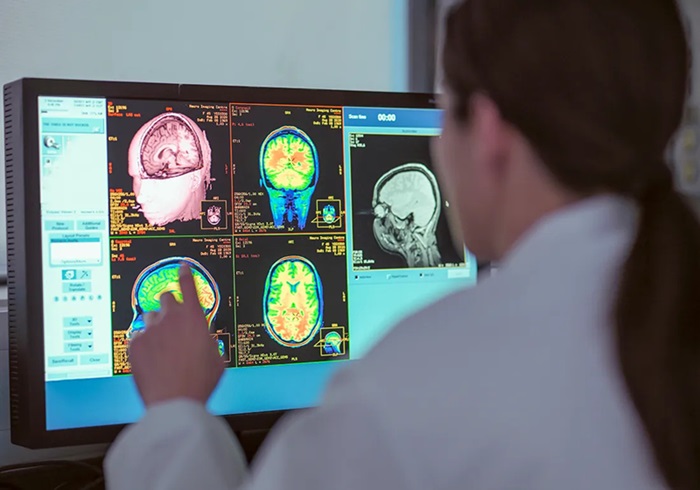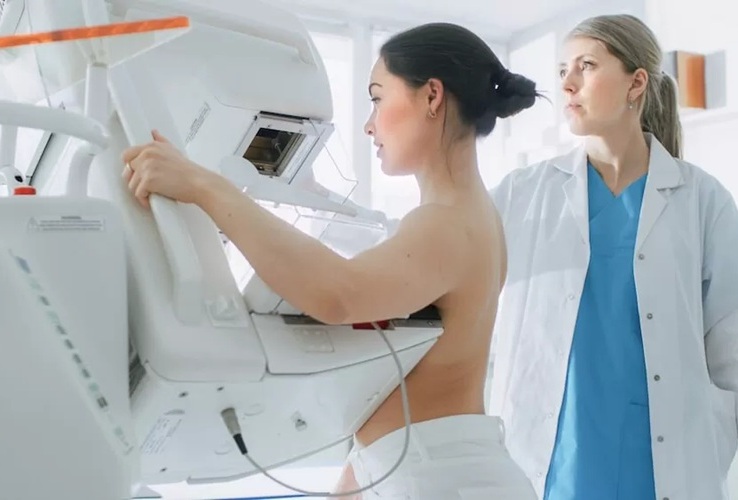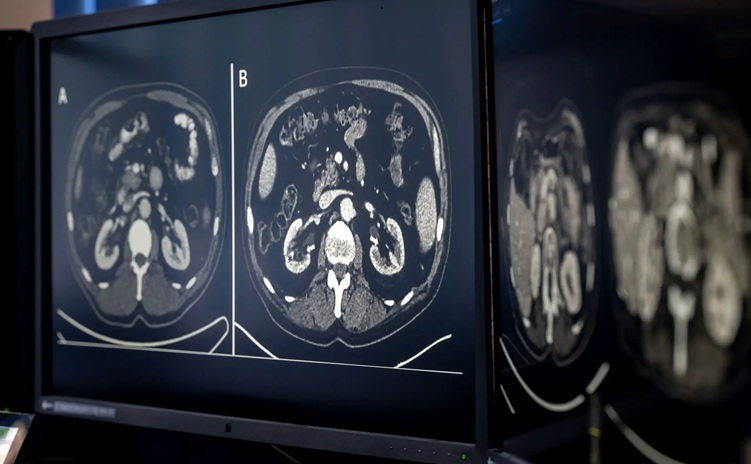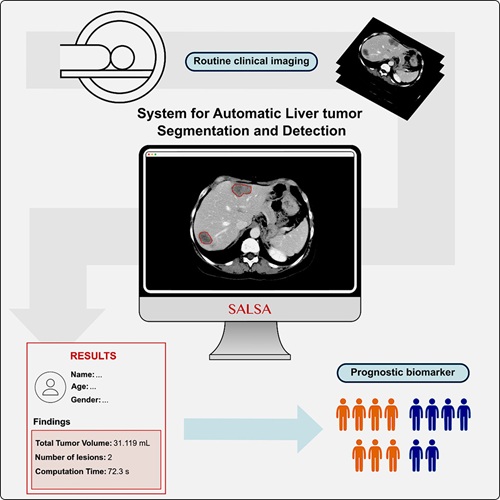MRI Provides Early Warning System for Glioblastoma Growth
|
By MedImaging International staff writers Posted on 02 Oct 2024 |

A new study has demonstrated the potential of combining imaging with radiation to shape glioblastoma treatment in real time. The research is the first to quantify tumor changes in glioblastoma patients undergoing MRI-guided radiation therapy, a novel technique known as MRI-linear accelerator or MRI-linac, which integrates daily imaging with radiation. The study revealed that daily imaging can serve as an early detection system for tumor growth during treatment, offering a timelier signal than standard imaging. This finding suggests that MRI-linac could be used in the future to rapidly adapt treatment during radiation therapy.
Researchers at the University of Miami Sylvester Comprehensive Cancer Center (Miami, FL, USA) tracked 36 glioblastoma patients over a six-week course of daily radiation and MRI scans using MRI-linac. The data from these daily scans were then compared to traditional imaging methods, which involve a single MRI with contrast before radiation therapy and another MRI one month after the treatment concludes. While MRI-linac can be used with contrast agents, many patients have concerns about the frequent use of these heavy metals, so the study was conducted using non-contrast daily scans. Typically, brain radiation is guided by X-ray or CT scans to position the patient under the radiation beam, but these scans only show the position of the skull. MRI-linac, however, allows clinicians to observe changes within the brain itself.
The study published in the International Journal of Radiation Oncology – Biology – Physics, revealed that in 74% of participants, the MRI-linac imaging results aligned with standard pre- and post-treatment MRI scans, both of which assessed whether the tumors had grown, shrunk, or remained stable during radiation. In the remaining 26% of patients, MRI-linac detected tumor growth even when standard imaging suggested tumor shrinkage. Although daily MRI scans did not always match the contrast imaging results, they successfully identified all cases of true tumor growth. This indicates that MRI-linac could be used as an early signal of potential tumor growth during radiation therapy, which could then be confirmed through contrast imaging. The technology may ultimately enable faster adjustments to treatment based on real-time tumor changes.
Daily imaging with MRI-linac could also be valuable beyond detecting tumor growth. If a tumor is shrinking, the radiation field could be narrowed to more precisely target only cancerous tissue. Additionally, most glioblastoma patients undergo surgery before radiation, and the size of the surgical resection cavity, where the tumor was removed, often decreases as the brain heals. Monitoring this shrinkage over time and adjusting the radiation field accordingly could help protect healthy tissue. In this study, the researchers monitored changes in both tumor size and the surgical cavity. The research team plans future studies to explore MRI-linac’s ability to guide treatment decisions during radiation therapy for glioblastoma patients and other types of brain cancer. Since few clinics currently use MRI-linac for brain cancer treatment, this study is among the first to show that glioblastomas can change significantly during radiation. The researchers aim to leverage this knowledge to improve outcomes for patients with this often-deadly form of cancer.
Latest MRI News
- New MRI Technique Reveals Hidden Heart Issues
- Shorter MRI Exam Effectively Detects Cancer in Dense Breasts
- MRI to Replace Painful Spinal Tap for Faster MS Diagnosis
- MRI Scans Can Identify Cardiovascular Disease Ten Years in Advance
- Simple Brain Scan Diagnoses Parkinson's Disease Years Before It Becomes Untreatable
- Cutting-Edge MRI Technology to Revolutionize Diagnosis of Common Heart Problem
- New MRI Technique Reveals True Heart Age to Prevent Attacks and Strokes
- AI Tool Predicts Relapse of Pediatric Brain Cancer from Brain MRI Scans
- AI Tool Tracks Effectiveness of Multiple Sclerosis Treatments Using Brain MRI Scans
- Ultra-Powerful MRI Scans Enable Life-Changing Surgery in Treatment-Resistant Epileptic Patients
- AI-Powered MRI Technology Improves Parkinson’s Diagnoses
- Biparametric MRI Combined with AI Enhances Detection of Clinically Significant Prostate Cancer
- First-Of-Its-Kind AI-Driven Brain Imaging Platform to Better Guide Stroke Treatment Options
- New Model Improves Comparison of MRIs Taken at Different Institutions
- Groundbreaking New Scanner Sees 'Previously Undetectable' Cancer Spread
- First-Of-Its-Kind Tool Analyzes MRI Scans to Measure Brain Aging
Channels
Radiography
view channel
Machine Learning Algorithm Identifies Cardiovascular Risk from Routine Bone Density Scans
A new study published in the Journal of Bone and Mineral Research reveals that an automated machine learning program can predict the risk of cardiovascular events and falls or fractures by analyzing bone... Read more
AI Improves Early Detection of Interval Breast Cancers
Interval breast cancers, which occur between routine screenings, are easier to treat when detected earlier. Early detection can reduce the need for aggressive treatments and improve the chances of better outcomes.... Read more
World's Largest Class Single Crystal Diamond Radiation Detector Opens New Possibilities for Diagnostic Imaging
Diamonds possess ideal physical properties for radiation detection, such as exceptional thermal and chemical stability along with a quick response time. Made of carbon with an atomic number of six, diamonds... Read moreUltrasound
view channel
New Incision-Free Technique Halts Growth of Debilitating Brain Lesions
Cerebral cavernous malformations (CCMs), also known as cavernomas, are abnormal clusters of blood vessels that can grow in the brain, spinal cord, or other parts of the body. While most cases remain asymptomatic,... Read more.jpeg)
AI-Powered Lung Ultrasound Outperforms Human Experts in Tuberculosis Diagnosis
Despite global declines in tuberculosis (TB) rates in previous years, the incidence of TB rose by 4.6% from 2020 to 2023. Early screening and rapid diagnosis are essential elements of the World Health... Read moreNuclear Medicine
view channel
New Imaging Approach Could Reduce Need for Biopsies to Monitor Prostate Cancer
Prostate cancer is the second leading cause of cancer-related death among men in the United States. However, the majority of older men diagnosed with prostate cancer have slow-growing, low-risk forms of... Read more
Novel Radiolabeled Antibody Improves Diagnosis and Treatment of Solid Tumors
Interleukin-13 receptor α-2 (IL13Rα2) is a cell surface receptor commonly found in solid tumors such as glioblastoma, melanoma, and breast cancer. It is minimally expressed in normal tissues, making it... Read moreGeneral/Advanced Imaging
view channel
First-Of-Its-Kind Wearable Device Offers Revolutionary Alternative to CT Scans
Currently, patients with conditions such as heart failure, pneumonia, or respiratory distress often require multiple imaging procedures that are intermittent, disruptive, and involve high levels of radiation.... Read more
AI-Based CT Scan Analysis Predicts Early-Stage Kidney Damage Due to Cancer Treatments
Radioligand therapy, a form of targeted nuclear medicine, has recently gained attention for its potential in treating specific types of tumors. However, one of the potential side effects of this therapy... Read moreImaging IT
view channel
New Google Cloud Medical Imaging Suite Makes Imaging Healthcare Data More Accessible
Medical imaging is a critical tool used to diagnose patients, and there are billions of medical images scanned globally each year. Imaging data accounts for about 90% of all healthcare data1 and, until... Read more
Global AI in Medical Diagnostics Market to Be Driven by Demand for Image Recognition in Radiology
The global artificial intelligence (AI) in medical diagnostics market is expanding with early disease detection being one of its key applications and image recognition becoming a compelling consumer proposition... Read moreIndustry News
view channel
GE HealthCare and NVIDIA Collaboration to Reimagine Diagnostic Imaging
GE HealthCare (Chicago, IL, USA) has entered into a collaboration with NVIDIA (Santa Clara, CA, USA), expanding the existing relationship between the two companies to focus on pioneering innovation in... Read more
Patient-Specific 3D-Printed Phantoms Transform CT Imaging
New research has highlighted how anatomically precise, patient-specific 3D-printed phantoms are proving to be scalable, cost-effective, and efficient tools in the development of new CT scan algorithms... Read more
Siemens and Sectra Collaborate on Enhancing Radiology Workflows
Siemens Healthineers (Forchheim, Germany) and Sectra (Linköping, Sweden) have entered into a collaboration aimed at enhancing radiologists' diagnostic capabilities and, in turn, improving patient care... Read more



















